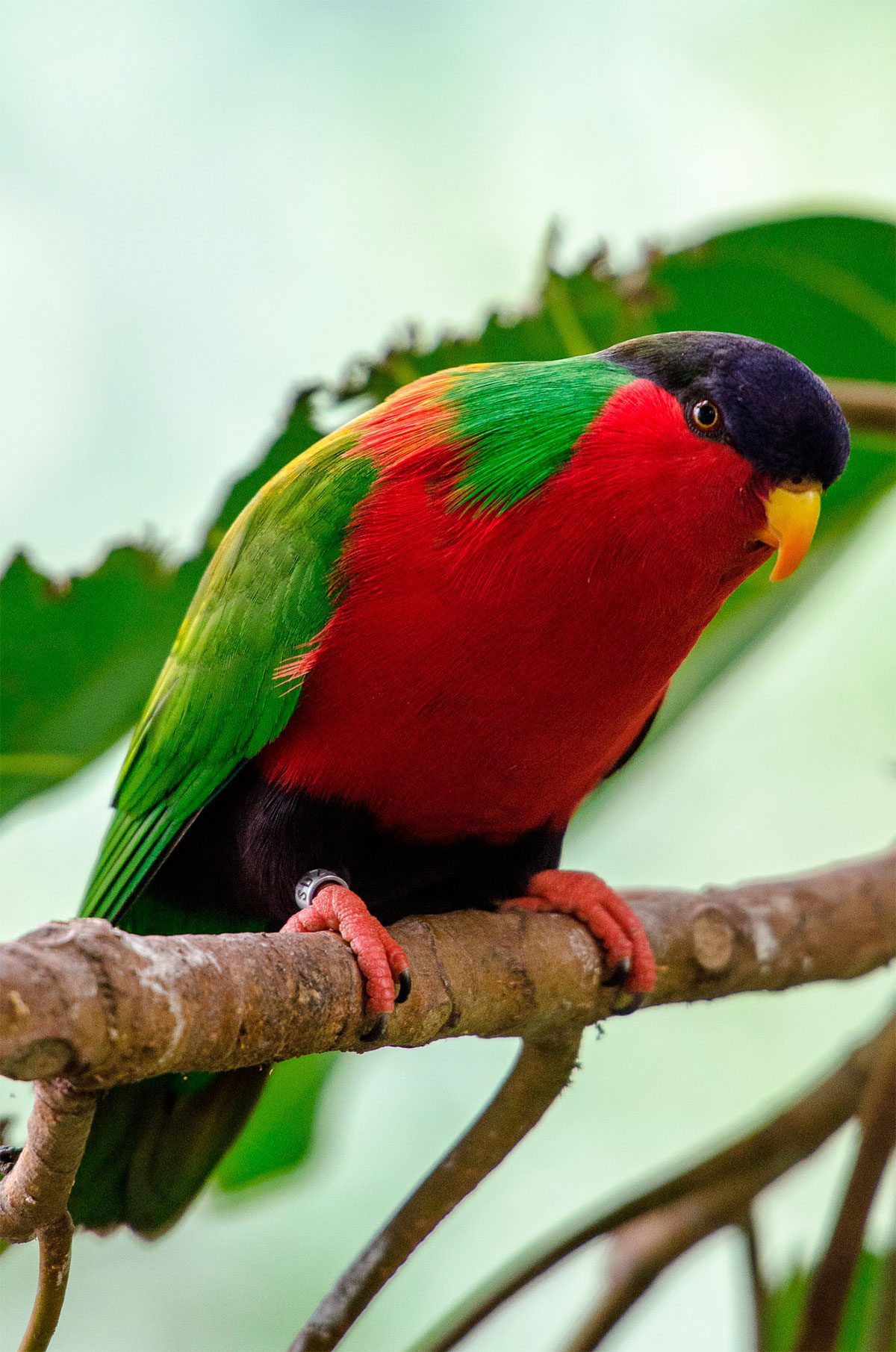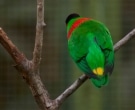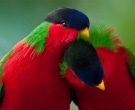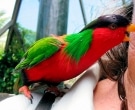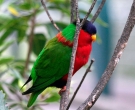Content |
|---|
Description
The Collared Lory (Phigys solitarius) has an approximate length of 20 cm.. and a weight ranging between 75 and 85 g..
The upper zone of the crown it is dark purple, In contrast with the ear-coverts, cheeks and throat that have a bright color red Scarlet;
The front of the crown, occasionally, with a mottled red light;
The tail feathers of the neck are of a green living with completion in red and a colorful blanket.
Under the the mantle, rump and top of the tail, bright green.
Upper wing green colour with the inside of the flight feather and coverts, in black color.
Underwing coverts Red and green. Underparts Scarlet Red, but with the bottom of the abdomen, lower side of the rump and the thighs, in dark purple.
Orange-yellow spot in Central feathers of the tail. Undertail Matt Brown-Green, showing orange spots on the basis.
Bill orange; Iris from yellow to red; Orange yellow the legs.
The females has more green under the nape, less red in the the mantle, a pronounced green glow in the crown back and a bright purple on the crown front.
The immature show freckles slightly purplish color and some greenish hidden spots in the chest; crown Green rear: they lack the elongated feathers red of the nape up to eight months of age. They lack orange spots in the tail. Bill more Brown than adults; irises brown: legs dark.
- Sound of the Collared Lory.
Habitat:
Visible and noisy. Found usually in pairs or in small groups of five to fifteen members, Although flocks have also been of up to 50 birds . They are mainly distributed in the lowlands of humid forest, edge of the forest, plantations and second growth up to 1,200 m, but they can be found anywhere with flowering gardens.
It is usually more common in wet windward areas, being less common on agricultural leeward coasts.
The Collared Lory are Mobile and something nomads, they are prepared to travel to almost any habitat with trees in bloom.
Often seen flying over trees or feeding are loud in acrobatic groups.
Reproduction:
The nesting they occur in the second half of the year, especially after August. Two white eggs are placed in a hollow tree. Adults aggressively defend the nesting sites.
In an instance of captive breeding, the incubation lasted 30 days and the young bird left the nest almost nine weeks later.
Food:
The diet of the Collared Lory consists of seeds, nectar and flowers. Trees of your choice include the drala (Erythrina variegata), the coconut tree (Cocoa nuts) and the African tulip introduced and invasive (Spathodea campanulata).
Also eat fruits as the Mango (Mangifera indica).
Distribution:
The Collared Lory is endemic of the Fiji Islands, including the main islands of Vanua Levu and Viti Levu, In addition to Rabbi, Taveuni, Koro, Wakaya, Ovalau, Gau, Ono, Kadavu, Matuku, Moala and some islands in the Lau group (Naitaba, Vatu Vara, Lakeba). In the extreme south of the Fiji Islands group, the Collared Lory It is replaced by the Blue-crowned Lorikeet.
The species is common and the world population is estimated between 10.000 and 100.000 specimens.
Some are kept in captivity. Red feathers were previously used by the Samoan and Tongan to make edges of floor mats, but trade does not seem to have had an impact on the abundance of the species in Fiji. Some birds are reported, they have escaped in Tonga and Samoa.
Conservation:
– Current IUCN Red List category: Least concern.
– The population trend: Stable.
The world's population has not been quantified, but the species is described as common in Viti Levu, the island of Vanua Levu and Makogai and rare in the Ngau island, Fiji.
The population It is suspected to be stable in the absence of evidence of any reduction or substantial threats.
"Collared Lory" in captivity:
Very rare to see them in captivity.
Alternative names:
– Collared Lory, Solitary Lory, Ruffed Lory, Fiji Lory (ingles).
– Lori des Fidji, Lori phigy (francés).
– Einsiedlerlori (alemán).
– Lóris-solitário (portugués).
– Lori Solitario (español).
scientific classification:
– Order: Psittaciformes
– Family: Psittaculidae
– Scientific name: Phigys solitarius
– Genus: Phigys
– Citation: (Suckow, 1800)
– Protonimo: lone parrot
Images “Collared Lory”:
Videos "Collared Lory"
————————————————————————————————
“Collared Lory” (Phigys solitarius)
Sources:
– Avibase
– Parrots of the World – Forshaw Joseph M
– Parrots A Guide to the Parrots of the World – Tony Juniper & Mike Parr
– Birdlife
– Photos:
1 – “Phigys solitarius - San Diego Zoo, California, USA-8a (1)” by DerekL123 from Cypress, USA – San Diego Zoo-48.jpgUploaded by snowmanradio. Licensed under CC BY-SA 2.0 via Wikimedia Commons.
2 – Collared lory (Vini [Phygis] solitarius) handjob by Chlidonias – ZooChat
3 – Collared Lory Perroquets – computer wallpapers
4 – Collared lory [Phigys solitarius] – Birds-pet-wallpapers
5 – By DickDaniels (http://carolinabirds.org /) (Own work) [CC BY-SA 3.0 or GFDL], via Wikimedia Commons
– Sounds: Matthias Feuersenger (Xeno-canto)
